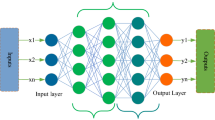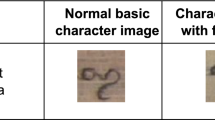Abstract
Chinese calligraphy is an important part of Chinese national culture and art and part of the essence of Chinese national culture. Stone calligraphy is one of the important elements of Chinese calligraphy art. Stone carved calligraphy characters have high cultural and artistic value. Therefore, accurately recognizing stone carved calligraphy characters are of great importance. Stone carved calligraphy can identify hard-to-preserve stone calligraphy paper materials in electronic data that can be preserved for a long time, thereby offering important reference materials for the study of the historical development of Chinese calligraphy art. Moreover, with the development of science and technology and the investment of China in cultural and artistic undertakings, computer-aided calligraphy character recognition technology is also constantly improving, and its application in calligraphy recognition is becoming increasingly extensive. This article aims to study a method of stone inscription calligraphy recognition based on convolutional neural networks. In this paper, we use an image recognition and optimization method consisting of a convolutional neural network to carry out an experiment with stone inscription calligraphy characters. It was concluded that the recognition accuracy of stone calligraphy characters by the convolutional neural network reached 99.2%, indicating that this stone calligraphy character recognition method based on a convolutional neural network has a good ability to recognize stone calligraphy characters.










Similar content being viewed by others
Data availability statement
The data that support the findings of this study are available from the corresponding author upon reasonable request.
References
Qian Y, Bi M, Tian T et al (2017) Deep convolutional neural networks for noise robust speech identification. IEEE/ACM Transforms Audio Speech Language Process 24(12):263–276
Liu M, Shi J, Zhen L et al (2017) Better analysis of deep convolutional neural networks. IEEE Trans Vis Comput Graphics 23(1):91–100
Shen W, Zhou M, F Yang, et al (2017) Multi-crop Convolutional Neural Networks for lung nodule malignancy suspiciousness classification. Pattern Recognition 61(21):663–673.
Mohsen GN et al (2017) Deep multi-scale location-aware 3D convolutional neural networks for automated detection of lacunes of presumed vascular origin - ScienceDirect. NeuroImage Clin 14(5):391–399.
Wu X, Luo C, Zhang Q et al (2019) Text detection and recognition for natural scene images using deep convolutional neural networks. Comput Mater Continua 61(1):289–300
Bostik O, Klecka J (2018) Recognition of CAPTCHA Characters by supervised machine learning algorithms. IFAC-PapersOnLine 51(6):208–213
Chen YH, Krishna T, Emer JS et al (2017) Eyeriss: an energy-efficient reconfigurable accelerator for deep convolutional neural networks. IEEE J Solid-State Circuits 52(1):127–138
Kruthiventi S, Ayush K, Babu RV (2017) DeepFix: a fully convolutional neural network for predicting human eye fixations. IEEE Trans Image Process 26(9):446–456
Lopes AT, Aguiar ED, Souza A et al (2017) Facial expression recognition with convolutional neural networks: coping with few data and the training sample order. Pattern Recogn 6(1):610–628
Hu C, Yi Z, Kalra MK et al (2017) Low-Dose CT with a residual encoder-decoder convolutional neural network (RED-CNN). IEEE Trans Med Imaging 36(99):524–535
Schirrmeister RT, Gemein L, Eggensperger K et al (2017) Deep learning with convolutional neural networks for decoding and visualization of EEG pathology. Hum Brain Mapp 38(11):391–420
Ma X, Zhuang D, He Z et al (2017) Learning traffic as images: a deep convolutional neural network for large-scale transportation network speed prediction. Sensors 17(4):8–18
Ragoza M, Hochuli J, Idrobo E et al (2017) Protein-ligand scoring with convolutional neural networks. J Chem Inf Model 57(4):9–42
Hou Y, Li Z, Wang P et al (2018) Skeleton optical spectra-based behaviour on identification using convolutional neural networks. IEEE Transforms Circuits Syst Video Technol 28(3):807–811
Fei C, Huang Y, Xin Z et al (2017) A robot calligraphy system: from simple to complex writing by human gestures. Eng Appl Artif Intell 59(5):1–14
Lei W, Gong X, Zhang Y et al (2017) Artistic features extraction from Chinese calligraphy works via regional guided filter with reference image. Multimedia Tools Appl 77(1):1–18
Akram Q, Hussain S (2019) Improving Urdu recognition using character-based Artistic Features of Nastalique Calligraphy. IEEE Access 7(99):495–507
Zheng Xu MM, Kamruzzaman, Jinyao Shi (2022) Method of generating face image based on text description of generating adversarial network. J Electronic Imag 31(5): 051411
Zhang X, Li Y, Zhang Z et al (2019) Intelligent Chinese calligraphy beautification from handwritten characters for robotic writing. Vis Comput 35(6):193–205
Alyafeai Z, Al-shaibani MS, Ghaleb M et al (2022) Calliar: an online handwritten dataset for Arabic calligraphy. Neural Comput Applic. https://doi.org/10.1007/s00521-022-07537-2
Funding
The author(s) received no financial support for the research, authorship, and/or publication of this article.
Author information
Authors and Affiliations
Corresponding author
Ethics declarations
Conflict of interest
The author(s) declared no potential conflicts of interest with respect to the research, author- ship, and/or publication of this article.
Additional information
Publisher's Note
Springer Nature remains neutral with regard to jurisdictional claims in published maps and institutional affiliations.
Ji-dan Huang, Guanjie Cheng, Jinghan Zhang are co-first author.
Rights and permissions
Springer Nature or its licensor (e.g. a society or other partner) holds exclusive rights to this article under a publishing agreement with the author(s) or other rightsholder(s); author self-archiving of the accepted manuscript version of this article is solely governed by the terms of such publishing agreement and applicable law.
About this article
Cite this article
Huang, Jd., Cheng, G., Zhang, J. et al. Recognition method for stone carved calligraphy characters based on a convolutional neural network. Neural Comput & Applic 35, 8723–8732 (2023). https://doi.org/10.1007/s00521-022-08049-9
Received:
Accepted:
Published:
Issue Date:
DOI: https://doi.org/10.1007/s00521-022-08049-9




